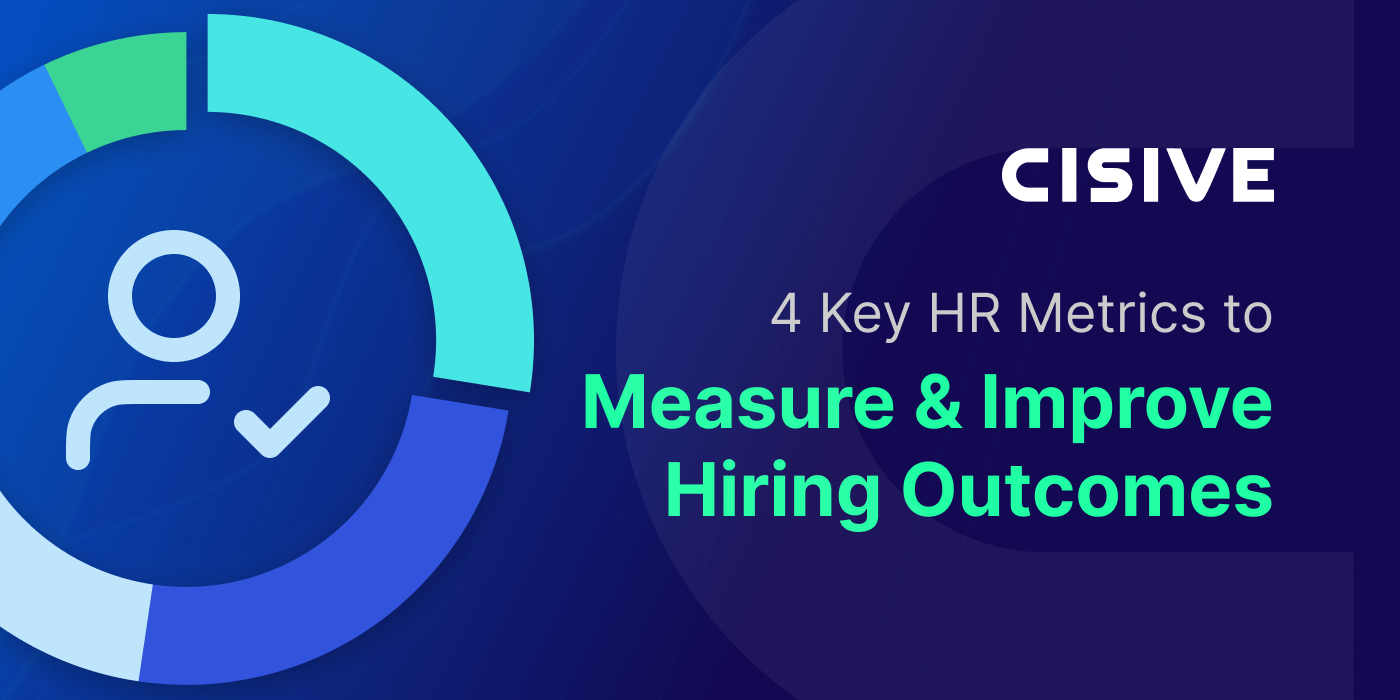

Most companies use data to drive decisions as much as possible. Metrics help guide leaders on...

Without data, how will you ever really know whether your efforts are working? How can you communicate your wins or losses to others in a way that’s relevant, actionable, and easy to understand?
If you’re not tracking key performance indicators (KPIs) and using them to assess your hiring process, you may be wasting resources. Without a clear understanding of your organization’s KPIs, you’ll never pinpoint problems and solve them.
It’s easy to see why KPIs are critical to human resources success. Hard data gathered over time is the only way to justify any form of process analysis or conclusion. Below, we look at four human resources metrics, why they’re important, and how to use them.
Key TakeawaysHere are the key things to know about HR metrics:
|
KPIs (key performance indicators) measure how effective your company is in meeting your business goals. They help you assess your performance, track the progress of your goals, and make data-driven decisions.
HR KPIs measure the effectiveness of your HR processes and initiatives within your company. HR KPIs can cover a wide range of areas, including:
There are many examples of HR KPIs. They include employee turnover rate, time to fill vacancies, employee satisfaction scores, training completion rates, and diversity metrics, to name a few. HR KPIs help you evaluate the effectiveness and efficiency of your HR strategy. You can identify areas for improvement and more closely align your efforts with organizational objectives.

An HR KPI ensures that your HR department's practices align with your company’s business model and marketing strategy. They allow you to identify areas for improvement and make informed decisions based on trending data over time.
Here’s what tracking your HR KPIs can help you do.
By analyzing key metrics, you can pinpoint areas where the department excels and areas that require improvement. You can allocate resources more effectively and invest in targeted training programs. You can also implement strategies that enhance overall departmental performance.
KPIs allow you to project where your HR department is headed and course-correct as needed. You can identify trends such as rising or falling engagement scores, diversity metrics, or appraisal outcomes. From there, you anticipate potential challenges or opportunities and adjust your strategy accordingly to attract and retain talent.
KPIs give you the confidence to make decisions based on real data, not conjecture. You can look at metrics like time to hire, training ROI, and turnover costs that contribute to effective strategic planning. You’ll also notice a more efficient process, which leads to a positive outcome for everyone in your department.

Here are the top examples of human resources KPIs to measure success:
What Is It? Employee turnover rate indicates the proportion of employees who leave your company within a specific time frame.
Importance: High turnover rates signal underlying issues such as dissatisfaction with work conditions, poor management, or lack of career advancement. Low turnover rates indicate a stable and satisfied workforce.
Calculation: Divide the number of employees who left during a certain period by the average number of total employees during that same period. Multiply by 100 to express the turnover rate as a percentage.
Employee Turnover Rate = (Number of Employees Who Left / Average Number of Total Employees) x 100
Example: Your company had 50 employees at the beginning of the year. You hired 20 new employees and had 10 employees leave during the same period. The turnover rate would be calculated as (10/70) x 100 = 14.29%.
What Is It? Time to hire is the number of days it takes for you to fill a vacant position. It starts when you post the job opening and ends when you hire a candidate.
Importance: Time to hire impacts your organization’s productivity and how candidates experience your hiring process.
Calculation: To calculate time to hire, subtract the date the candidate accepts the job offer from the date you posted the job. The duration provides a clear measure of how efficient your recruitment process is.
Time to Hire = Date Candidate Accepted Offer – Date Job Opening Was Posted
Example: Your company posts a job opening for a software developer position on January 1. After conducting interviews, you extend a job offer to a candidate, who accepts on February 1. The time to hire for this position would be 31 days.
What Is It? Cost per hire totals all expenses involved in filling vacant positions with a new employee. It includes all direct and indirect costs throughout the recruitment process, from job postings to onboarding.
Importance: You can assess the cost of your recruitment processes and adjust as needed. You can also budget for future hires with greater accuracy, allocating resources only where necessary.
Calculation: To calculate the cost per hire, sum up all expenses directly related to the recruitment process. Costs may include advertising, job fairs, recruiter fees, background checks, and applicant tracking system costs. Divide this total by the number of hires made within a specific time frame.
Cost per Hire = Total Recruitment Costs / Total Number of Hires
Example: Your company spends $50,000 on recruitment in a year. Costs include advertising, recruiter fees, and background checks. During the same period, you filled 100 vacant positions. To calculate the cost per hire, divide the total recruitment expenses ($50,000) by the number of hires (100), resulting in a cost per hire of $500.
What Is It? Quality of hire is the level of success a new employee achieves in their role. It evaluates how well new hires perform their duties and contribute to the company’s success.
Importance: You can evaluate how well you hire and align new employees with your company’s objectives. You identify strengths and weaknesses in your hiring strategies and make necessary adjustments to improve employee outcomes.
Calculation: To determine the quality of hire, evaluate new employees based on various performance metrics. These may include sales performance, engagement, and retention rates.
Quality of Hire = (Performance Score + Engagement Score + Retention Score) / 3
Example: A company hires an engineer who delivers quality work, contributes to projects, and stays on for more than a decade. The employee demonstrates a high quality of hire. Conversely, several new hires struggle to perform job duties effectively or leave the organization shortly after being hired. If this happens consistently, it indicates a lower overall quality of hire metric.
At any given time, you're measuring multiple KPIs at various levels to address a range of issues. You may be dealing with absenteeism in one department while managing hiring delays in another.
You may also notice that these challenges never seem to go away. It’s an ongoing struggle to maintain a highly efficient, cost-effective process over long periods.
Cisive’s human capital management (HCM) technology provides onboarding solutions backed by analytics tools that give you understandable, relevant, and actionable recruitment data. You can automate many of your processes to generate KPIs with greater speed and accuracy.
The Cisive Analytic Reporting Tool (CART) tracks your progress and delivers insights into how your hiring decisions impact your organization. Get reports on billing analysis, volume analysis, turnaround times, and background checks.
Integrating KPIs into your recruitment process and learning how to optimize them makes you a valuable asset to your HR team. KPIs serve as benchmarks that help you identify where you can save time and money while retaining top talent.
Cisive’s advanced HCM solutions can put you on the right track by helping you identify hiring challenges and fix them faster. Speak to HCM experts today and get started with our proven HR solutions.
Author: Cisive Staff
Bio: Contributed by a member of our staff with expertise in background screening for highly regulated industries.
Let's Connect on LinkedIn
Most companies use data to drive decisions as much as possible. Metrics help guide leaders on...

Many HR disasters occur as a result of compliance issues, inadequate training, and ineffective...

How Generative AI Will Transform HR Generative AI isn’t just a buzzword; it’s a game-changer poised...